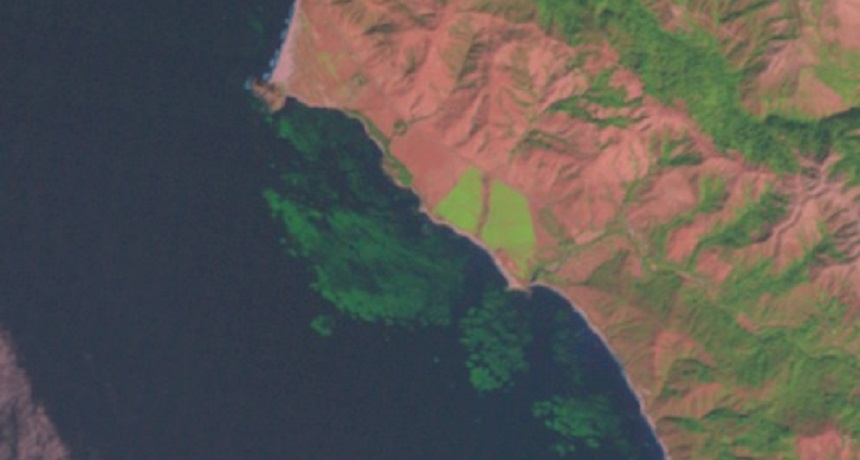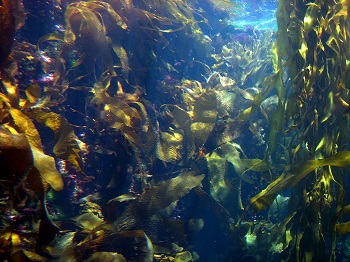Find floating forests for science
A new citizen-science project lets you hunt kelp beds from your computer

This is a satellite image of Carmel, Calif., taken from Landsat satellites. The bright green floating kelp are clearly visible. To a Floating Forest citizen scientist, this photo is a winner.
Floating Forests
Kelp is a type of seaweed that can grow 30 centimeters (about a foot) per day. Some large species can grow more than 60 meters (200 feet) long. In oceans around the world fish, mammals, reptiles and even birds dart in and out of huge forests full of this kelp. But the ocean is vast, and nobody knows just how many kelp forests exist or how big they get. Now, citizen scientists can find out, with a new citizen-science project called Floating Forests.
Seaweeds are the foundation of some ocean ecosystems. They turn sunlight into energy. Animals feed on them. Prey species hide from predators in a seaweed’s shade. And forests of kelp, the largest of these algae, can even calm strong waves before they approach the shore.

Some kelp forests get so large they can be seen from space. That’s a very good thing for marine biologists. Usually, they study kelp by diving underwater. While this is probably a lot of fun for the biologists, they can only collect kelp samples if they know where to look. And scientists don’t know where all the kelp forests are, or how they might be changing over time.
So marine biologists are enlisting the help of citizen scientists. These are members of the public who volunteer to help scientists, usually by measuring or monitoring fairly simple things. Three groups teamed up to create the new venture: the Kelp Ecosystem Ecology Network, the Santa Barbara Coastal Long-Term Ecological Research Project and the National Center for Ecological Analysis and Synthesis. Called Floating Forests, their project asks volunteers to find large beds of kelp.
Participants view a series of images from Landsat. This is a series of NASA satellites that have been taking photos of Earth since the 1970s. Many of those photos show the ocean. A few of those may contain kelp beds. At first, it’s a little hard to tell what’s a kelp bed and what isn’t. I ended up clicking through a lot of photos that were nothing but clouds or land. But once you see the bright green smear in the ocean on your screen, it’s like hitting a jackpot! The project is so addictive, it’s more like a game.
The images provided by Floating Forests could be 30 years old, or they could have been taken last week. When you see the telltale green smears in the water denoting a likely kelp bed, you use your mouse to circle it. Then you click a button to submit your discovery. Your eagle eyes will help scientists more effectively home in on kelp to probe the role it’s playing in ocean health.
Follow Eureka! Lab on Twitter
Power Words
algae Single-celled organisms, once considered plants. As aquatic organisms, they grow in water. Like green plants, they depend on sunlight to make their food.
citizen science Scientific research in which the public — people of all ages and abilities — participate. The data that these citizen “scientists” collect helps to advance research. Letting the public participate means that scientists can get data from many more people and places than would be available if they were working alone.
ecosystem A group of interacting living organisms — including microorganisms, plants and animals — and their physical environment within a particular climate. Examples include tropical reefs, rainforests, alpine meadows and polar tundra.
habitat The area or natural environment in which an animal or plant normally lives, such as a desert, coral reef or freshwater lake. A habitat can be home to thousands of different species.
kelp Large seaweeds that are usually a type of algae called brown algae, though they may appear brown, yellow or green. They grow underwater and form large forests which provide habitat for many organisms. Some kelp forests are so large they are visible from space.
seaweed Large algae growing in the sea or on rocks below the high-water mark.